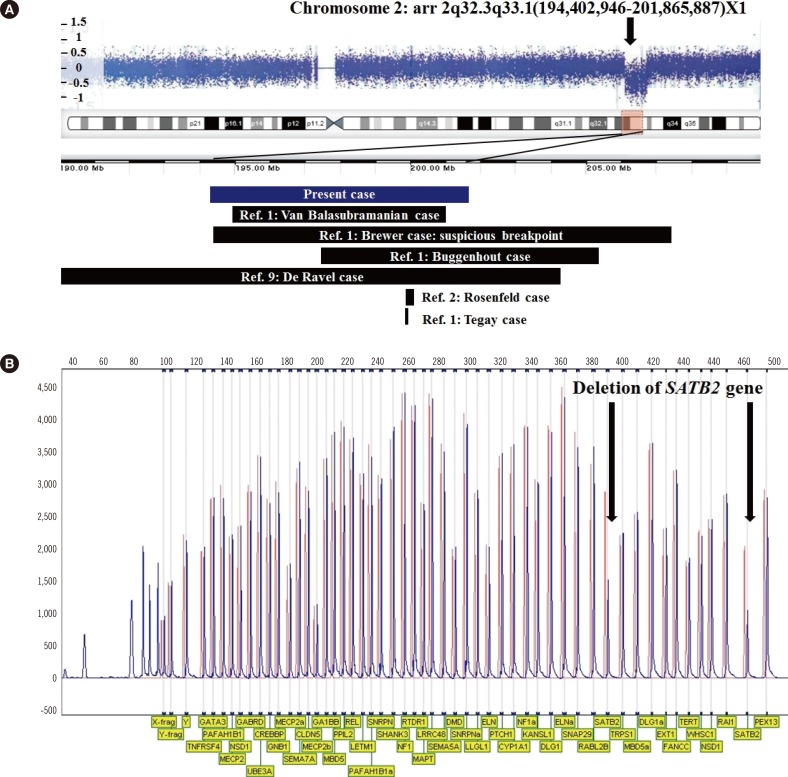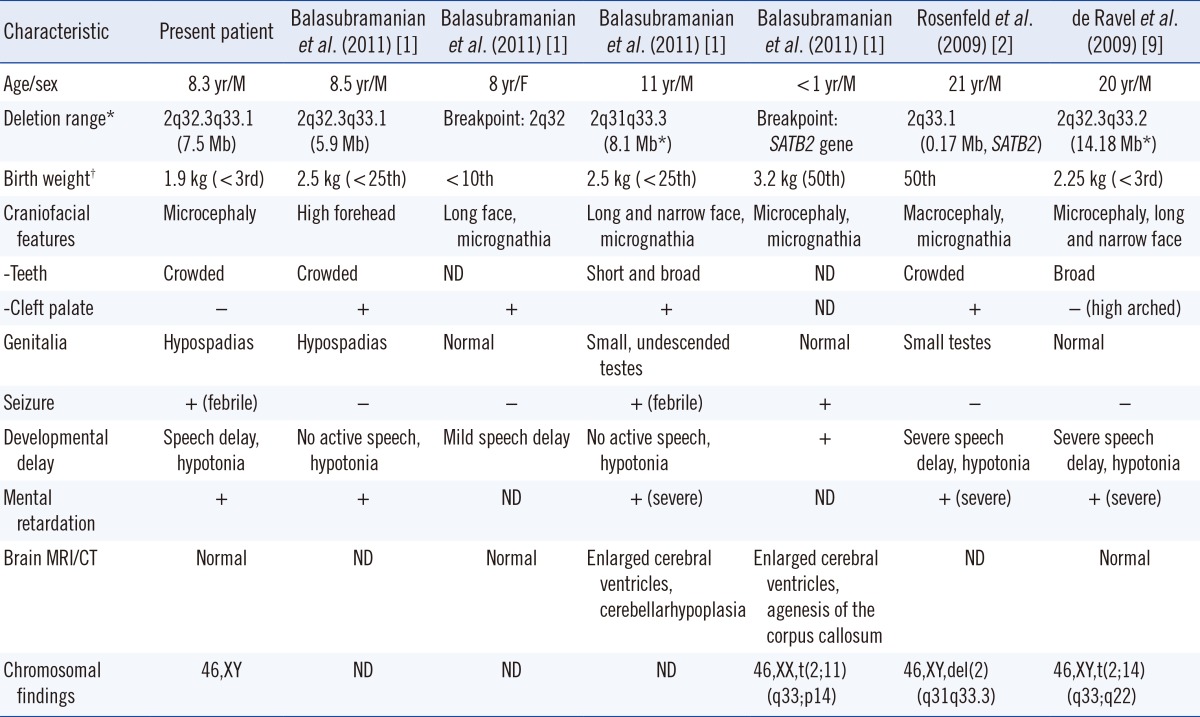Chromosome 2q32-q33 deletion syndrome (Online Mendelian Inheritance in Man [OMIM]*612313) is a chromosomal disorder that was recently characterized by chromosomal microarray (CMA) analysis [1, 2]. We present the first Korean case of 2q32-q33 microdeletion syndrome, which was diagnosed by CMA and multiplex ligation probe amplification (MLPA).
The patient was an 8-yr-old boy, the first child of Korean parents with no relevant family history. He was delivered via cesarean section at full term (39 weeks' gestation) with a birth weight of 1.9 kg (<3rd percentile) and was admitted to the neonatal intensive care unit for one month. Standard karyotyping using peripheral blood showed no abnormalities, and his brain ultrasonogram was normal. He had hypospadias and undescended testicles at birth and underwent surgical repair (urethroplasty and bilateralorchiopexy) at 15 months. Delayed motor development was apparent at 6 months, and he could not walk until 32 months. Developmental evaluation at the age of 4 yr using the Denver developmental screening test revealed a motor delay of 16 months and social cognitive delay. Delayed acquisition of language skills, mental retardation, and central hypotonia were also established at that time. The patient had visited the emergency department intermittently because of recurrent non-febrile seizure (generalized tonic clonic). He had also been to a dentist to address crowded teeth and dental caries.
At the age of 8 yr and 4 months, the patient was admitted again for seizure. Brain magnetic resonance imaging yielded normal findings. On physical examination, body weight of 18.4 kg (<3rd percentile), height of 124.8 cm (25th-50th percentile), head circumference of 50 cm (3rd percentile), and craniofacial dysmorphic features, including microcephaly and crowded teeth, were found. Written informed consent for genetic analysis was obtained from the parents according to the ethical guidance of the institutional review board. CMA (Cytoscan 750K array; Affymetrix, Santa Clara, CA, USA) analysis revealed a 7.5-Mb interstitial deletion on 2q32.3-33.1, which contained 28 genes: arr 2q32.3q33.1(194,402,946-201,865,887)×1 (SLC39A10, DNAH7, STK17B, GTF3C3, PGAP1, ANKRD44, SF3B1, HSPD1, MOB4, RFTN2, HSPE1, MARS2, BOLL, PLCL1, SATB2, FTCDNL1, TYW5, SPATS2L, KCTD17, SGOL2, AOX1, NIF3L1, BZW1, CLK1, PPIL3, NIF3L1, ORC2, FAM126B) (Fig. 1A). SATB2 deletion on 2q33.1 was confirmed (rsa 2q33.1×1) (Fig. 1B) by MLPA using the MLPA P245 kit (MRC-Holland, Amsterdam, Netherlands).
SATB2 gene (OMIM*608148), a critical region in 2q32-q33 microdeletion syndrome, specifically binds to the nuclear matrix attachment regions involved in transcriptional regulation and chromatin remodeling and shows remarkable evolutionary conservation [3]. SATB2 gene regulates craniofacial development and cortical neuron differentiation. Thus, SATB2 gene acts as a molecular node in the transcriptional network regulating skeletal development and osteoblast differentiation [4]. SATB2 haploinsufficiency is considered a cause of craniofacial dysmorphism (including cleft palate), mental retardation, and autism spectrum disorders associated with deletions and translocations at 2q32-q33 [5]. Recently, a novel clinical entity termed SATB2-associated syndrome, characterized by severe intellectual disability, speech delay, cleft or high-arched palate, and abnormal dentition (crowded and irregularlyshaped teeth), was proposed [3]. The current patient fit that clinical and molecular profile with the exception of a cleft palate. Genetic analysis with CMA, a first-tier screening tool for unexplained developmental delay in many other countries [6, 7], is essential in the diagnosis and clear delineation of 2q32-q33 microdeletion syndrome. Currently, in Korea, CMA cannot be performed for routine diagnostic purposes for a child with developmental delay. Therefore, this patient was not properly diagnosed until the age of 8 yr, despite a strong suspicion of a genetic basis.
To date, less than 30 cases of 2q32-q33 microdeletion syndrome involving various sizes of deletions have been reported [1, 2, 8, 9]. Some of these cases and their characteristics are summarized in Table 1. Craniofacial dysmorphism, developmental delay, and mental retardation were commonly present, and hypospadias occurred in only one patient [1]. The deleted region in the patient with hypospadias (chr2: 194,947,694-200,850,112) was also entirely deleted in the present patient (Fig. 1A). The phenotypic differences seen in these two patients were seizure (seen only in our patient) and cleft palate (seen only in the other patient). This implies that genes other than SATB2 are involved in the development of cleft palate, and that the distal 1-Mb region of the deletion end in this patient (chr2: 200,850,112-201,865,887) might include the genetic cause of recurrent seizures. Although many genes have been suggested as the genetic cause of hypospadias [10], the deleted genes the above two cases have in common could also be candidate genes for hypospadias. Given the variability in the observed phenotype, additional case studies are needed to elucidate the role of each of those genes.
Acknowledgments
This study was supported by a grant from the Korea Health Technology R&D Project, Ministry of Health & Welfare, the Republic of Korea (A120030).
References
1. Balasubramanian M, Smith K, Basel-Vanagaite L, Feingold MF, Brock P, Gowans GC, et al. Case series: 2q33.1 microdeletion syndrome--further delineation of the phenotype. J Med Genet. 2011; 48:290–298. PMID: 21343628.

2. Rosenfeld JA, Ballif BC, Lucas A, Spence EJ, Powell C, Aylsworth AS, et al. Small deletions of SATB2 cause some of the clinical features of the 2q33.1 microdeletion syndrome. PLoS One. 2009; 4:e6568. PMID: 19668335.

3. Döcker D, Schubach M, Menzel M, Munz M, Spaich C, Biskup S, et al. Further delineation of the SATB2 phenotype. Eur J Hum Genet. 2014; 22:1034–1039. PMID: 24301056.

4. Zhao X, Qu Z, Tickner J, Xu J, Dai K, Zhang X. The role of SATB2 in skeletogenesis and human disease. Cytokine Growth Factor Rev. 2014; 25:35–44. PMID: 24411565.

5. FitzPatrick DR, Carr IM, McLaren L, Leek JP, Wightman P, Williamson K, et al. Identification of SATB2 as the cleft palate gene on 2q32-q33. Hum Mol Genet. 2003; 12:2491–2501. PMID: 12915443.

6. Nicholl J, Waters W, Mulley JC, Suwalski S, Brown S, Hull Y, et al. Cognitive deficit and autism spectrum disorders: prospective diagnosis by array CGH. Pathology. 2014; 46:41–45. PMID: 24300712.

7. Miller DT, Adam MP, Aradhya S, Biesecker LG, Brothman AR, Carter NP, et al. Consensus statement: chromosomal microarray is a first-tier clinical diagnostic test for individuals with developmental disabilities or congenital anomalies. Am J Hum Genet. 2010; 86:749–764. PMID: 20466091.

8. Urquhart J, Black GC, Clayton-Smith J. 4.5 Mb microdeletion in chromosome band 2q33.1 associated with learning disability and cleft palate. Eur J Med Genet. 2009; 52:454–457. PMID: 19576302.
9. de Ravel TJ, Balikova I, Thiry P, Vermeesch JR, Frijns JP. Another patient with a de novo deletion further delineates the 2q33.1 microdeletion syndrome. Eur J Med Genet. 2009; 52:120–122. PMID: 19284984.

10. van der Zanden LF, van Rooij IA, Feitz WF, Franke B, Knoers NV, Roeleveld N. Aetiology of hypospadias: a systematic review of genes and environment. Hum Reprod Update. 2012; 18:260–283. PMID: 22371315.

Fig. 1
Chromosomal microarray profile of chromosome 2. (A) The whole chromosome 2 view shows copy number loss in the 2q32.3-33.1 region. Blue dots with a log2 value of -1 represent a 1:2 copy number ratio of the test to reference genomic DNA, indicating a heterozygous deletion (arrow). The expansion view of the 2q32-33 region revealed a 7.5-Mb heterozygous interstitial deletion in chr2:194,402,946-201,865,887 (including SATB2 gene). Bars represent the deletion sizes in the current case and other 2q32-q33 microdeletion syndrome cases. (B) MLPA analysis (red: control, blue: patient) results show heterozygous deletion of SATB2 gene on 2q33.1 (arrows), rsa 2q33.1×1.
Abbreviation: MLPA, Mutiplex ligation-dependent probe amplification.

Table 1
Comparison of the present patient with other reported patients with 2q32-q33 microdeletion syndrome or translocation involving 2q32

*The minimal range of deletion is described because the deleted region was confirmed by fluorescent in situ hybridization; †Numbers in parentheses show percentile score of birth weight.
Abbreviations: GTC, generalized tonic clonic; ND, no data applicable; MRI, magnetic resonance imaging; CT, computed tomography.




 PDF
PDF ePub
ePub Citation
Citation Print
Print


 XML Download
XML Download